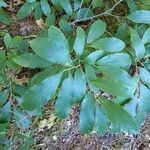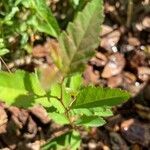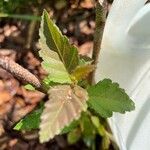An evergreen tree. It grows 20-30 m tall. It can be a large suckering shrub. It is often 4.5 m tall and 6 m wide. The bark is red-brown and furrowed into scaly plates. The young shoots are downy. The young leaves are white and furry on the underside. The leaves are 7.5-15 cm long by 3-5 cm wide. They have many straight parallel side veins. There are many very small white male flowers in catkins 10-15 cm long. These are at the base of leaves. There are a few female flowers 3 mm long at the base of smaller catkins. The nuts are inside spiny burrs. The nuts themselves are like round pointed acorns. They are edible.
Shrub 2–5 m, often colonial, or occasionally a small tree; lvs lance-oblong to oblong-obovate, to 15 cm, or longer on rapidly growing shoots, sharply serrate with ascending or salient teeth to merely bristle-toothed, gray-tomentose beneath; staminate spikes to 15 cm; involucres 2–3.5 cm thick, usually several or many in a large, compact head or spike, the nuts solitary, ovoid, terete, 1–1.5 cm. Dry or moist acid soil; s. N.J. to Ky. and Ark., s. to Fla. and Tex. Ours is var. pumila. C. ×neglecta Dode is a hybrid with no. 1 [Castanea dentata (Marshall) Borkh.].




